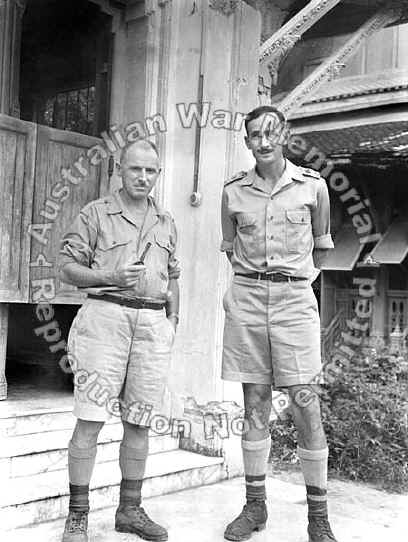|
Sir Edward "Weary"
Dunlop was a surgeon in the
Australian Army during World War Two. He served in the Middle East and
he is legendary for his care of soldiers taken prisoner by the Japanese.
His nickname might have
been 'Weary' but his nature certainly wasn't. Even in the most horrific
conditions Weary found energy to fight for the well being and often, the
lives of these men.
Weary grew up on farms in
country Victoria. He loved adventures and he liked to prove he was
tougher than the rest. " I used to walk down barefoot and jump on
top of my favourite riding horse and round up the horses - it was quite
an impressive cavalcade." Weary was a natural athlete and at school
in Benalla, he preferred to play sport than to study.
When he left school Weary
took a job in a pharmacy. But he grew bored with small town life and
headed for Melbourne in 1927. Here Weary took a new career path, and
began studying medicine at Melbourne University. He also played with
Australia's national rugby team, The Wallabies, and was a champion
boxer.
Soon after graduating
Weary took a job as a ship's surgeon and sailed to London. The next year
World War Two broke out. Weary knew his skills were needed closer to the
action.
"I just couldn't get
into the army quick enough"
About a year after
enlisting in the Australian Army, Weary was sent to the Middle East and
from there to Java in Indonesia. The Japanese had attacked the island,
and Weary was needed to help treat the casualties. But just two weeks
after his arrival Japanese troops captured the town where Weary was
living. The prisoners were taken by ship from Singapore to Burma, and
then crammed into train carriages for a five day horror ride into
Thailand.
The Japanese wanted to
build a four hundred and twenty one kilometre long railway from west
Thailand into Burma. The work required physical strength and good tools.
The prisoners had neither. "I'd see these fellas off at the crack
of dawn, just carrying their rice for the day, and then they would drag
in any time up until midnight, some of them on their hands and
knees."
 |
| Bone;
Large sequestrum (section of dead bone) from a tibia (shin bone)
damaged by a tropical ulcer. The bone has irregular jagged edges
and has been partially cut with a saw near a blue stain.
Associated with VX259 Lieutenant Colonel Edward Ernest 'Weary'
Dunlop. He removed this piece of bone, which was eroded by a
tropical ulcer, from the shin bone of a British subaltern who was
a prisoner of war at Tarsau in 1944. The officer recovered full
use of the limb after plastic reconstruction. Dunlop used the bone
as a specimen in lectures after the war. |
As a commander, Weary had
the awful job of deciding who was fit enough to work. As a surgeon, he
was also the one who patched the men up after their hours of hard labour.
Standing nearly two metres tall, Weary had to stoop as he operated on
patients beneath kerosene lamps.
Former prisoner of War,
Bill Griffiths is among the many who owe their lives to Weary. The
Japanese planned to kill him. What use is a disabled man, it was argued.
Weary stepped in front of the bayonets and refused to move until Bill's
life was spared.
A habit of keeping track
of the war via a hidden wireless also landed Weary in the firing line.
"I got handcuffed around a tree, my tummy exposed to four bayonets
and a countdown. Things were pretty grim." Weary ended up being
tortured instead but the experience only made him more defiant.
 |
BANGKOK, THAILAND.
1945-09-15. LIEUTENANT COLONEL E.E. DUNLOP, COMMANDING OFFICER,
2/2ND CASUALTY CLEARING STATION (RIGHT), AND LIEUTENANT COLONEL
A.E. COATES, CHIEF MEDICAL OFFICER, NAKOM PATON PRISONER OF WAR
HOSPITAL (LEFT), OUTSIDE THEIR OFFICE AT THE MEDICAL HEADQUARTERS,
RECOVERED ALLIED PRISONERS OF WAR AND INTERNEES UNIT, AT THE
CHINESE COLLEGE. |
When the war was over,
Weary continued to work as a surgeon in Australia and in Asia. In 1969
he was knighted in recognition of his contribution to medicine. Weary's
compassionate nature enabled him to forgive and even meet, some of his
former enemies.
Finally, in 1993, ten
days short of his 86th birthday, Sir Edward Weary Dunlop died. Over ten
thousand people lined the streets of Melbourne for the state funeral of
the man they called 'The Surgeon of the Railway'.
"I have a conviction
that it's only when you are put at full stretch that you can realise
your full potential."
some wording from http://www.rugby.unimelb.edu.au/weary.html |